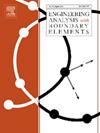A hybrid R-LES-SPH model for numerical simulation of hydrodynamic problems with violent free-surface flows
IF 4.1
2区 工程技术
Q1 ENGINEERING, MULTIDISCIPLINARY
Engineering Analysis with Boundary Elements
Pub Date : 2025-07-25
DOI:10.1016/j.enganabound.2025.106405
引用次数: 0
Abstract
This paper proposes a novel hybrid R-LES-SPH model for numerical analysis of hydrodynamic problems involving violent free-surface flows. In this model, while viscous diffusion is imposed by a Large Eddy Simulation (LES) formulation in the Lagrangian framework with integrating into the dissipation limiter of the Riemann-SPH (RSPH) model, density diffusion is by a diffusive term connected with Roe’s approximate Riemann solver with dynamic reconstruction. The present hybrid approximation aims to ensure numerically stable analyses with smooth pressure fields, without introducing excessive energy dissipation. In the proposed model, enhanced Particle Shifting (PS) and Volume Conservation Shifting (VCS) schemes are implemented to prevent irregular particle distribution and volume conservation issues faced in the Smoothed Particle Hydrodynamics (SPH) simulations. The solution accuracy and energy conservation properties of the proposed R-LES-SPH model are investigated using several benchmark cases. The proposed model computations are compared with experimental and analytical solutions together with the RSPH and δ-LES-SPH computations. The results showed that the proposed R-LES-SPH model offers more stable and accurate computations with a smoother pressure field and similar energy conservation properties compared to the δ-LES-SPH model. In addition to this, it is observed that the proposed model prevents excessive numerical dissipation with more realistic calculations of viscous forces compared to the RSPH model.
具有剧烈自由表面流动的混合R-LES-SPH模型数值模拟
本文提出了一种新的混合R-LES-SPH模型,用于涉及剧烈自由表面流动的水动力问题的数值分析。在该模型中,粘性扩散是由拉格朗日框架中的大涡模拟(LES)公式施加的,并集成到黎曼- sph (RSPH)模型的耗散限制器中,而密度扩散是由一个与罗伊近似黎曼求解器连接的扩散项施加的,并具有动态重构。目前的混合近似旨在确保在光滑压力场下的数值稳定分析,而不引入过多的能量耗散。在该模型中,采用增强的粒子移动(PS)和体积守恒移动(VCS)方案来防止光滑粒子流体动力学(SPH)模拟中面临的不规则粒子分布和体积守恒问题。通过几个基准算例研究了所提出的R-LES-SPH模型的求解精度和节能性能。将模型计算结果与实验解、解析解以及RSPH和δ-LES-SPH计算结果进行了比较。结果表明,与δ-LES-SPH模型相比,R-LES-SPH模型具有更平滑的压力场和相似的能量守恒特性,计算更加稳定和准确。此外,与RSPH模型相比,所提出的模型与更真实的粘性力计算相比,可以防止过多的数值耗散。
本文章由计算机程序翻译,如有差异,请以英文原文为准。
求助全文
约1分钟内获得全文
求助全文
来源期刊

Engineering Analysis with Boundary Elements
工程技术-工程:综合
CiteScore
5.50
自引率
18.20%
发文量
368
审稿时长
56 days
期刊介绍:
This journal is specifically dedicated to the dissemination of the latest developments of new engineering analysis techniques using boundary elements and other mesh reduction methods.
Boundary element (BEM) and mesh reduction methods (MRM) are very active areas of research with the techniques being applied to solve increasingly complex problems. The journal stresses the importance of these applications as well as their computational aspects, reliability and robustness.
The main criteria for publication will be the originality of the work being reported, its potential usefulness and applications of the methods to new fields.
In addition to regular issues, the journal publishes a series of special issues dealing with specific areas of current research.
The journal has, for many years, provided a channel of communication between academics and industrial researchers working in mesh reduction methods
Fields Covered:
• Boundary Element Methods (BEM)
• Mesh Reduction Methods (MRM)
• Meshless Methods
• Integral Equations
• Applications of BEM/MRM in Engineering
• Numerical Methods related to BEM/MRM
• Computational Techniques
• Combination of Different Methods
• Advanced Formulations.
 求助内容:
求助内容: 应助结果提醒方式:
应助结果提醒方式:


